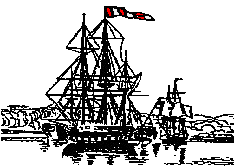A language on it's own
When you enter the world of sailing, you discover new horizons which also have their own language. Many words will be strange to you, some you will know already and others take on new meanings. Here are just a few terms and phrases:
Heaving
Heaving is the taking up slack (or putting tension on a line) in a line in a controlled manner. This term is applied to both ropes and anchor chains. If an anchor chain is pulled in before departure it is said that one heaves up the anchor.
Once a line is heaved in or up it is belayed to a belaying pin or bollard. Letting go of a line is called easing.
Portside
Portside means the left side of a ship, airplane or spaceship looking to the front of the vessel. Originally called larboard and starboard, since large ships started using wheels instead of a tiller the term larboard has been altered to portside. Why this was done is still a matter of discussion in the nautical establishment.
The portside navigation light on a ship
or airplane is red.
Belaying pin
A belaying pin is a short pin that is
usually rounded at the top and generally gets smaller to
the end of the pin. They are used for belaying a rope to
the pinrail. Originally they where made from wood but
since the second half of the 19th century they are made
in different sizes and materials with the benefit of
strength. It also enables one to distinguish between
different ropes in the dark by touch. On large sailing
ships as well as smaller traditional ships belaying pins
are still the norm. On modern yachts and ships cleats
have replaced belaying pins.
Brace
A brace is part of the running rigging of
a square rigged sailing ship. Braces are attached to the
yard ends and are used to brace the yard around (to turn
the yard from for example port to starboard),
horizontally around the mast. This has the function to
turn the sail that is bent onto the yard, for optimal
wind angel.
Bracing to leeward is called hard to weather.
Bow
The bow is the front part of a ship's
hull. The bow should be streamlined for maximum speed
through the water. The aft end of a ship is called the
stern. The front part of the bow is called the stem and
on wooden ships this is made out of a large wooden log.
Over the years as ships have developed, the bow has
taken on numerous shapes for practical as well as
esthetical reasons.
Easing
Easing is a shipping term whereby a rope or chain is eased (letting go in a controlled manner). This can also be applied to the anchor chain. The opposite of easing is heaving (taking up the slack in a line).
Keel
The keel is found underwater midships of
the ship and acts as the ship's backbone. To the keel
the frames run diagonally from the keel to the deck.
From the keel the ship's construction goes over in to
the bow and the stern. For sailing ships a keel has the
secondary function of reducing drift by providing
resistance underwater.
Unlike a leeboard a keel is generally fixed and of
considerable weight. On different ships, one can find
many different keel shapes.
Jib boom
The jib boom could be a loose spar or on
larger ships a fixed jib boom attached to the bowsprit.
To prevent it from breaking, the jib boom is stayed with
a bobstay, guy's and a martingale. The larger the ship,
the more of these stays can be applied. Underneath the
jib boom some ships employ a net to enhance the safety
for crew working there.
With heavy weather or in port the jib boom can be
dismounted. To the jib boom one can set the following
foresails: flyer, outer jib, inner jib and the
forestaysail.
Pinrail
The pinrail is usually a wooden structure through which the belaying pins are placed. In general pinrails are placed on the inside of the bulwarks between the shrouds and the bollards.
Starboard
Starboard is defined as the right hand
side of a ship, airplane or spaceship. This is on the
assumption that one always looks to the front of the
ship (bow). The term comes from old sailing ships where
the helmsman was standing on the right side of the ship.
The starboard navigation light is green.

